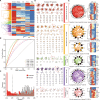Transcriptional profiling reveals the transcription factor networks regulating the survival of striatal neurons
- PMID: 33712552
- PMCID: PMC7955055
- DOI: 10.1038/s41419-021-03552-8
Transcriptional profiling reveals the transcription factor networks regulating the survival of striatal neurons
Abstract
The striatum is structurally highly diverse, and its organ functionality critically depends on normal embryonic development. Although several studies have been conducted on the gene functional changes that occur during striatal development, a system-wide analysis of the underlying molecular changes is lacking. Here, we present a comprehensive transcriptome profile that allows us to explore the trajectory of striatal development and identify the correlation between the striatal development and Huntington's disease (HD). Furthermore, we applied an integrative transcriptomic profiling approach based on machine learning to systematically map a global landscape of 277 transcription factor (TF) networks. Most of these TF networks are linked to biological processes, and some unannotated genes provide information about the corresponding mechanisms. For example, we found that the Meis2 and Six3 were crucial for the survival of striatal neurons, which were verified using conditional knockout (CKO) mice. Finally, we used RNA-Seq to speculate their downstream targets.
Conflict of interest statement
The authors declare no competing interests.
Figures






Similar articles
-
Transcriptional regulatory networks underlying gene expression changes in Huntington's disease.Mol Syst Biol. 2018 Mar 26;14(3):e7435. doi: 10.15252/msb.20167435. Mol Syst Biol. 2018. PMID: 29581148 Free PMC article.
-
Cortical efferents lacking mutant huntingtin improve striatal neuronal activity and behavior in a conditional mouse model of Huntington's disease.J Neurosci. 2015 Mar 11;35(10):4440-51. doi: 10.1523/JNEUROSCI.2812-14.2015. J Neurosci. 2015. PMID: 25762686 Free PMC article.
-
Systems Genetic Analyses Highlight a TGFβ-FOXO3 Dependent Striatal Astrocyte Network Conserved across Species and Associated with Stress, Sleep, and Huntington's Disease.PLoS Genet. 2016 Jul 8;12(7):e1006137. doi: 10.1371/journal.pgen.1006137. eCollection 2016 Jul. PLoS Genet. 2016. PMID: 27390852 Free PMC article.
-
Molecular insights into cortico-striatal miscommunications in Huntington's disease.Curr Opin Neurobiol. 2018 Feb;48:79-89. doi: 10.1016/j.conb.2017.10.019. Epub 2017 Nov 7. Curr Opin Neurobiol. 2018. PMID: 29125980 Free PMC article. Review.
-
Nature and cause of mitochondrial dysfunction in Huntington's disease: focusing on huntingtin and the striatum.J Neurochem. 2010 Jul;114(1):1-12. doi: 10.1111/j.1471-4159.2010.06741.x. Epub 2010 Apr 9. J Neurochem. 2010. PMID: 20403078 Review.
Cited by
-
The Principle of Cortical Development and Evolution.Neurosci Bull. 2025 Mar;41(3):461-485. doi: 10.1007/s12264-024-01259-2. Epub 2024 Jul 18. Neurosci Bull. 2025. PMID: 39023844 Free PMC article. Review.
-
The transcription factor Zfp503 promotes the D1 MSN identity and represses the D2 MSN identity.Front Cell Dev Biol. 2022 Aug 23;10:948331. doi: 10.3389/fcell.2022.948331. eCollection 2022. Front Cell Dev Biol. 2022. PMID: 36081908 Free PMC article.
-
Transcription factor Sp9 is a negative regulator of D1-type MSN development.Cell Death Discov. 2022 Jun 30;8(1):301. doi: 10.1038/s41420-022-01088-0. Cell Death Discov. 2022. PMID: 35773249 Free PMC article.
-
Comprehensive Analysis of Hub Genes Associated With Competing Endogenous RNA Networks in Stroke Using Bioinformatics Analysis.Front Genet. 2022 Jan 12;12:779923. doi: 10.3389/fgene.2021.779923. eCollection 2021. Front Genet. 2022. PMID: 35096003 Free PMC article.
-
A primate nigrostriatal atlas of neuronal vulnerability and resilience in a model of Parkinson's disease.Nat Commun. 2023 Nov 18;14(1):7497. doi: 10.1038/s41467-023-43213-2. Nat Commun. 2023. PMID: 37980356 Free PMC article.
References
Publication types
MeSH terms
Substances
LinkOut - more resources
Full Text Sources
Other Literature Sources
Medical
Molecular Biology Databases
Miscellaneous

